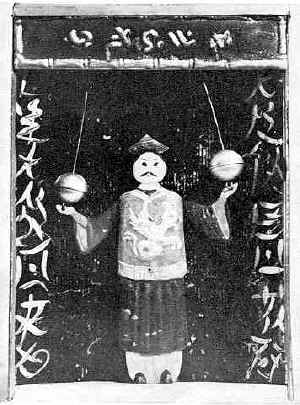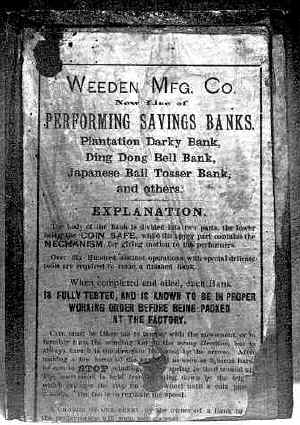Japanese Ball Tosser
by F.H. Griffith - HOBBIES Magazine - September, 1973
 There is no question in the writer’s mind that so far as his
hobby goes the greatest challenge facing him over the years was to be the first collector
of mechanical banks to turn up an elusive wind-up tin mechanical known as the Japanese
Ball Tosser. All odds seemed to be against this ever becoming a reality. He has had in his
possession for some time evidence that the bank had been produced. Heard rumors of one
existing in a West Coast collection that never materialized. Now and then someone thinking
they had seen one some place — and so on, but never the bank itself.
There is no question in the writer’s mind that so far as his
hobby goes the greatest challenge facing him over the years was to be the first collector
of mechanical banks to turn up an elusive wind-up tin mechanical known as the Japanese
Ball Tosser. All odds seemed to be against this ever becoming a reality. He has had in his
possession for some time evidence that the bank had been produced. Heard rumors of one
existing in a West Coast collection that never materialized. Now and then someone thinking
they had seen one some place — and so on, but never the bank itself.
All this Japanese Ball Tosser intrigue started in the early days of his collecting, first with rumors that such a bank had been made. Years later in 1955 at the time of the Chrysler sale and disposal of the Corby collection the writer was fortunate enough to obtain a mint condition Ding Dong Bell with the original box. This box as shown in Figure 2 had important bearing on the Japanese Ball Tosser. Please note the wording on the box and the evidence that Weeden Manufacturing Company most surely had made a Japanese Ball Tosser. Then in 1961 he found an old catalog of the Chas. Schmidt Toy & Notion Company, dated October 1, 1888, that pictured the bank for sale at $9.00 per dozen. Another old catalog also came into his possession that listed the bank for sale.
So to get to the point of all this, at long last, and to the best of the writer’s knowledge, we picture in Figure 1 the first Japanese Ball Tosser known to exist. It is necessarily at this point No. 226 in the numerical classification, and is in all original condition except for the head of the figure. This was a clean neat break at the neckline and the part has been properly replaced. It really is one of the great action mechanicals and the balls are tossed up and down 80 times for a penny.
The bank has two companion mechanicals, Weeden’s Plantation Darky Savings Bank and Ding Dong Bell. All three were made by Weeden Manufacturing Company of New Bedford, Mass., and all were covered by the same patent. They have similar spring wound mechanisms with sustained action for a certain length of time.
 Colors of the bank are as follows: The sides are blue with wording
in gold and coins in silver and copper. Each side is the same as those used on the Ding
Dong Bell. The bank has the original paper label on the back with the instructions
thereon, and the coin trap is the same as used on the two companion banks. The top is
orange-red. The important decorative front of the bank has the stage background in black
with gold Japanese writing down the sides. This background section is finely fluted —
that is to say fine vertical lines are stamped in the tin. The top overhanging section is
in green with gold lettering and gold bamboo representation. The figure has a red jacket
or smock with gold dragon and gold bottom and top. The flowing sleeves of his shirt and
the skirt-like part of his costume are blue. The inside drape part of the sleeves and his
trousers are tan. His shoes are black and hat blue. Face and hands are natural yellowish
cast and the features are black, as is his hair. The wooden base or stage on which he
stands is orange and the balls are gold. This completes the coloring of a most attractive
bank.
Colors of the bank are as follows: The sides are blue with wording
in gold and coins in silver and copper. Each side is the same as those used on the Ding
Dong Bell. The bank has the original paper label on the back with the instructions
thereon, and the coin trap is the same as used on the two companion banks. The top is
orange-red. The important decorative front of the bank has the stage background in black
with gold Japanese writing down the sides. This background section is finely fluted —
that is to say fine vertical lines are stamped in the tin. The top overhanging section is
in green with gold lettering and gold bamboo representation. The figure has a red jacket
or smock with gold dragon and gold bottom and top. The flowing sleeves of his shirt and
the skirt-like part of his costume are blue. The inside drape part of the sleeves and his
trousers are tan. His shoes are black and hat blue. Face and hands are natural yellowish
cast and the features are black, as is his hair. The wooden base or stage on which he
stands is orange and the balls are gold. This completes the coloring of a most attractive
bank.
To operate the bank the mechanisms is first wound, then a coin, as with its companion banks, is pushed into the provided slot in the lower left side. Immediately his arms move up and down as the balls do the same thing, giving the proper effect of his tossing the balls in the air. This action also causes the figure to move slightly from side to side. The juggling takes place for a timed period and on inserting another coin the action is repeated.
Other than the fact the Japanese Ball Tosser may have been made in a limited quantity or over a short period of time, there is no question but that the bank is a very delicate and involved piece of mechanism and this alone could account for its scarcity. It is a quite fragile bank and it is remarkable that the one shown has survived in the nice condition that it is in. To point this up further, take the Weeden’s Plantation, which is a not too difficult bank to obtain. But how many do you find in nice original condition? Very limited, since even some of the larger collections do not have a fine example of this bank therein. And the working parts and mechanism of the Japanese Ball Tosser are considerably more delicate and involved than either of its companion banks.
The whole situation surrounding the Japanese Ball Tosser and an example finally coming to light has been a most meaningful experience for the writer. For referral purposes, the Ding Dong Bell article appeared in HOBBIES, October 1954, and Weeden’s Plantation, August, 1963.
In closing the writer would like to re-mention the realistic action of the Japanese Ball Tosser. The balls snap into the air in such fashion that it actually looks as though the figures were tossing them.
A final word. Notice in Figure 2 the statement under the three named banks — "and others." Also on the paper label on the back of the Japanese Ball Tosser appears "Weeden Manfg. Co. — New Line Of Mechanical Savings Banks — Six Styles." This poses the possibility that Weeden made three other banks that we know nothing about. A friend of the writer’s claims that he had in his hands a bank similar to the Plantation, however, it was a schoolmaster with a paddle spanking a pupil. Years ago the writer heard of such a bank, but it turned out to be only hearsay. So where do we go from here? Only time will tell. We now know of three different kinds of Weeden’s banks — could there be a fourth — a fifth — possibly a sixth?
